Known variously as the ‘Flying Pancake,’ ‘Flying Flapjack,’ ‘Flying Saucer,’ and ‘Zimmerman’s Skimmer,’ the V-173 was a bizarre US attempt to create a UFO-like craft that could act in the same way as a helicopter.

Additionally considered as a potential military weapon in the XF5U-1, this saucer-shaped oddity’s promising start would be ruined by an accident-plagued flight program and the emergence of superior jet engine technology.
Origins
Inspired by the small circular winged aircraft developed by Chicago-based innovators Cloyd Snyder, Steve Nemeth, and Richard Johnson in the 1930s, Charles Horton Zimmerman, an aviation engineer who had distinguished himself working on state-of-the-art wind tunnel machines, was determined to go one step further than his contemporaries.
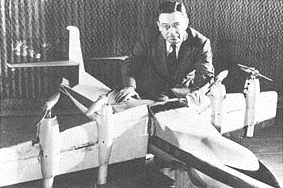 Zimmerman with tiltwing model for wind tunnel testing. Zimmerman was a forward thinking designer who produced some interesting concepts.
Zimmerman with tiltwing model for wind tunnel testing. Zimmerman was a forward thinking designer who produced some interesting concepts.
In 1936 he sketched out a craft that would have a near flat body in the style of a pancake, would accommodate three operators, and would rest on the ground in a prone position before changing to an upright position during flight. Although Zimmerman’s design went to the very extremes, it was surprisingly fully funded by NACA.
Zimmerman’s first prototype was complete in no time, but engine failures meant it never flew – to the relief of many observers who considered the contraption a death trap.
Going back to the drawing board Zimmerman, employing a rudimentary 20-inch rubber band-powered model, was soon able to prove that at least theoretically his concept worked.
Development
The next year, Zimmerman’s flirtations with the Flying Pancake caught the eye of Eugene Wilson. He was the president of the United Aircraft Corporation, and was curious to see if a scaled-up version was possible.
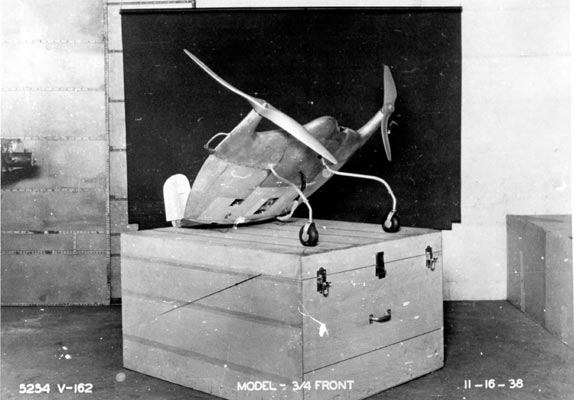 A model of the V-162 for testing. This is what became the Flying Pancake. Photo credit – Vought.
A model of the V-162 for testing. This is what became the Flying Pancake. Photo credit – Vought.
Leaving his role as chief of the Stability and Control Section at NACA, Zimmerman took up employment as a designer for Chance Vought Aircraft Division, a subsidiary company based in Stratford, Connecticut.
Provided with all the necessary resources by Wilson, Zimmerman started piecing together an advanced model demonstrator called the V-162.
Evaluated inside a hangar, the prototype performed remarkably well with its chopper-like characteristics. Assessors were confident it could be fine-tuned into an effective short take-off and landing (STOL) aircraft.
Convinced he had stumbled onto a revolutionary new aviation layout and determined to protect his idea from prying eyes, in February 1938 Zimmerman filed a US patent registered 2,108093 for a semi-circular low aspect ratio aircraft he referred to as the ‘Aeromobile’.
In late 1938 believing it to have the potential for military use, Zimmerman offered his design and an attack bomber variant to the US Army.
Although impressed by what they saw, they declined, principally because Chance Vought was primarily a US Navy contractor, one of their biggest interdepartmental rivals.
 This model was important in testing the concept before a full-size aircraft could be built. Photo credit – Vought.
This model was important in testing the concept before a full-size aircraft could be built. Photo credit – Vought.
Following Vought’s merger with Sikorsky in 1939, the Aeromobile piqued the interest of the US Navy, who authorized a contract stipulating that after Zimmerman and his team had conducted a series of wind tunnel tests with scale models, they were to assemble a full proof-of-concept prototype called the V-173.
V-173
The V-173 was 8.13 meters in length, 3.9 meters high, and had a wingspan of 7.16 meters in addition to a wing area of 39.66 meters. Made from wood and aluminium with a fabric covering and almost completely flat, it was extremely light weighing in at a mere 1,024 kilograms.
Elsewhere at its rear, it was fitted with an all-moveable ‘flying tail’ for stability, while beneath its fixed landing gear gave it a 22-degree nose-high ground angle.
It was propelled by two rather underwhelming Continental A-80 piston engines which powered dual three-bladed propellers of around 5 meters each.
Being only an experimental aircraft it was fed by a meagre 75 litres of fuel, giving it a top speed of 138 miles per hour, a cruise speed of 75 miles per hour, and the ability to climb up to 5,000 feet in 7 minutes.
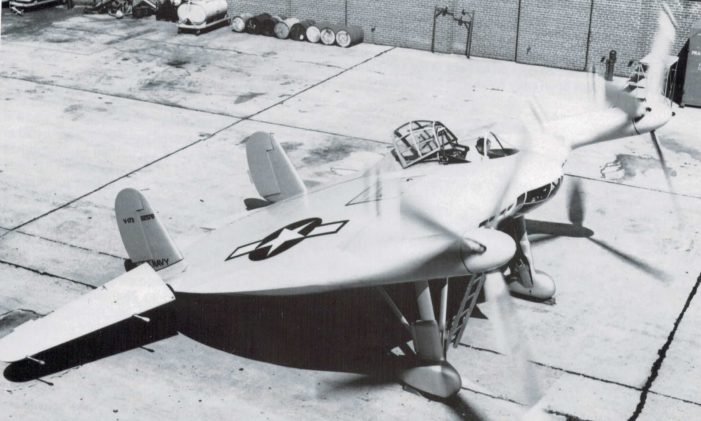 The V-173 had an extremely unconventional design.
The V-173 had an extremely unconventional design.
Testing
Following weeks of taxi runs on November 23rd 1942, piloted by Boone Guyton, the V-173 made its first test flight at Stratford that involved travelling around the perimeter of the facility for 13 minutes. In a later recollection of the flight, Boone hinted at the veil of secrecy that surrounded the project:
“As I pulled into the wind, I noticed the police guard searching for cameras among cars parked along the road by the runway. Kids hanging on the fence were ushered back.”
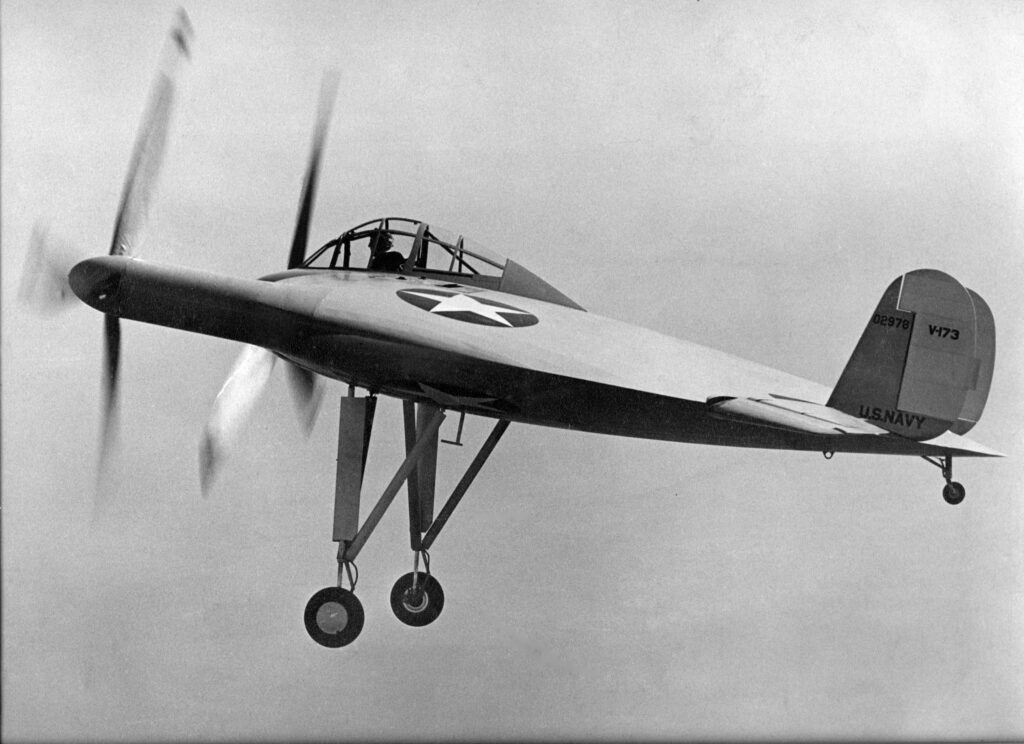 In-flight, the V-173 produced huge amounts of noise and vibrations.
In-flight, the V-173 produced huge amounts of noise and vibrations.
Aside from experiencing only minor difficulties with the controls because of improperly balanced control surfaces, evaluators were blown away by the shortness of the 15-meter touchdown distance required to land it safely.
On the other hand, the V-173 remained one of the noisiest air vehicles, with a distracting vibration frequency generated by the propellers buzzing all around the cockpit, a problem that not even the addition of vibration dampeners could fix.
It was also one of the least comfortable, with Guyton noting how he developed back ache from leaning forward to see where he was going since the cockpit was almost adjacent to the wing’s leading edge.
Guyton never used the plexiglass openings on the floor, believing them to be completely useless. In addition after 40 or 50 flights, a stabilizing flap was added to the trailing wing edge, which helped the tail get down effectively during a low or no-power landing.
Behaviour
 After some testing had occurred, the V-173 had additional stabilising flaps.
After some testing had occurred, the V-173 had additional stabilising flaps.
Throughout 131 hours of testing the oddness of how the V-173 operated came to the fore. Pilots Boone Guyton, Richard Burroughs, Charles A.
Lindbergh and a few other Navy aviators, including Lieutenant Najeeb E. Halaby, the future head of the FAA, reported that despite its tendency to fly completely nose-up that complete lateral and longitudinal control was still maintained. Boone perspicaciously remarked on the implications this could have in a combat situation:
“Throughout the entire flight test program we were never able to make the airplane stall completely or even approach a spinning condition.
A noticeable flight characteristic was the rapid decrease in speed as the airplane was pulled into a tight turn. I found this deceleration to be almost a fascination that would make the plane a formidable opponent in a dogfight.”
Accidents
However, because of its weak engine power, the V-173 was known to be difficult to manoeuvre. This was especially true on touch down when its nose would suddenly tilt down, leading to a number of accidents.
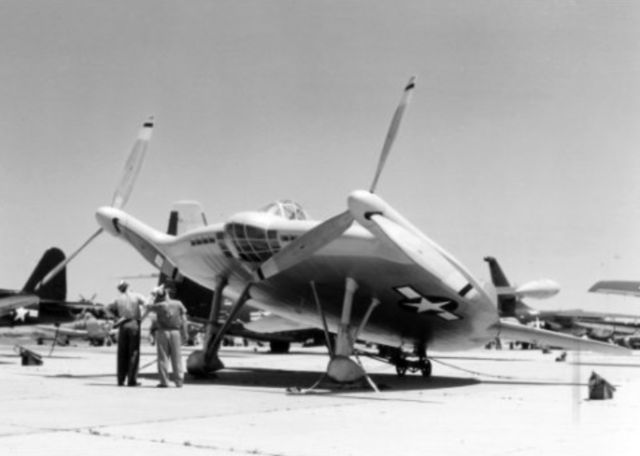 The design brought along a new set of challenges including poor low-speed handling leading to a number of accidents.
The design brought along a new set of challenges including poor low-speed handling leading to a number of accidents.
The first occurred on June 3rd 1943, when a fuel issue forced test pilot Richard Burroughs, drafted in after Guyton was seriously injured in an F4U Corsair crash, to make an emergency landing on Lordship Beach just below Bridgeport on Long Island Sound.
Missing a highly startled sunbather by a matter of meters, the aircraft crashed and flipped over, with the beachgoer’s towel later found underneath the upturned Pancake.
June 3rd 1945 witnessed a similar incident when Burroughs would again be compelled to crash land Zimmerman’s Skimmer onto the Mill River Golf Course after suffering engine failure. Being a classified project, the plane was later put on guard and towed back to the factory in the dead of night.
The last close call happened in 1947 during Chance Vought’s 30th Anniversary Airshow when a recuperated Boone Guyton was suddenly unable to lift the V-173 adequately because of the hot summer air, resulting in the near miss of some high-tension cables and a rock face situated at the end of the runway.
XF5U-1
As the V-173 was being prepared for its first flight, a parallel project using the same design was also being explored by the US Navy.
In September 1941 they requested Zimmerman to construct two military versions of the Flying Pancake, designated VS-315 – but later known as XF5U-1.
By June 7th 1943 a wooden mockup of the proposed fighter, assembled with ‘flapping blades’ instead of propellors to avoid persistent vibration, was completed. On July 5th 1944 the Navy officially issued Zimmerman a contract worth 250,000 dollars.
The resulting prototype differed from the V-173 in several aspects. The most significant change was to the propulsion system.
A pair of Pratt & Whitney R-2000-7 engines were installed, giving it a forecasted and greatly increased top speed of 425 mph.
Fuel capacity was also considerably up to 1,186 litres, and its range is expected to be around 1,000 miles.
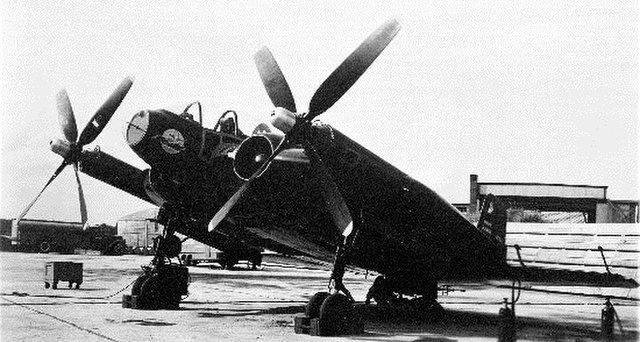 The XF5U was developed from the V-173 and took the initial design a step further.
The XF5U was developed from the V-173 and took the initial design a step further.
Furthermore, this version of the Flying Saucer was to be armed to the teeth. Provisions for either six .50 calibre machine guns or four 20 mmm cannons and two 1,000 lb bombs were provided.
However like its V-173 counterpart, the XF5U-1 was cancelled in 1947 because of the advent of much superior jet aircraft.
Aftermath
After the discontinuation of the program, the Navy ordered Lee C. Stetson, the same man who had assembled both XF5U-1s, to destroy them.
With essential components removed, the Flying Flapjacks were squashed by a wrecking ball and then systematically cut up.
As for the V-173, following its 171st flight in 1947, it was retired and donated to the Smithsonian National Air and Space Museum.
It was placed into a storage facility in Suitland, Maryland until the end of the 20th century.
In 2000, the V-173 was removed from storage at the request of former Chance Vought employees who wanted to make it flightworthy again.
 The Flying Pancake now resides as a museum piece. Photo credit – Eric Urban CC BY-SA 4.0.
The Flying Pancake now resides as a museum piece. Photo credit – Eric Urban CC BY-SA 4.0.
In 2003 after being dismantled and shipped across six states to the Vought plant in Dallas, Texas, an ageing engineering team of 22 octogenarians undertook its restoration over 8 years.
They overhauled its poorly performing engines, replaced the aircraft’s cotton fabric skin, fitted cockpit plexiglass, and revamped internal components.
This was with the assistance of a rotating steel framework allowing the aircraft to be turned to different positions.
Repainted in its original yellow and silver colour scheme, the Flying Pancake was exhibited at the Dallas Frontiers of Flight Museum in 2012. After this, it was returned to the Smithsonian, where it has remained ever since.
If you like this article, then please follow us on Facebook and Instagram.
Specifications
Crew: One, pilot
Length: 26 ft 8 in (8.128 m)
Wingspan: 23 ft 4 in (7.1 m)
Height: 14 ft 9 in (4.51 m)
Gross weight: 2,258 lb (1,024 kg)
Powerplant: 2 × Continental A-80 horizontally opposed, four-cylinder engines, 80 hp (60 kW) each each
Maximum speed: 138 mph (222 km/h, 120 kn)





